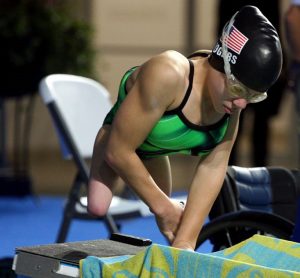
THE COMPETITIVE EDGE
I may have only about half my spine and not much in the way of legs, but I am an athlete to the core. I started swimming when I was 3, and entered my first track race around the same age. It may seem surprising, but there are a lot of sports opportunities for people with physical disabilities, including those who have SA/CRS. This involvement has more benefits than you can count. So far, the sports I’ve tried include ice hockey, water skiing, basketball, football, floor hockey, hand cycling, swimming, track, and field. I’m now training in Paralympic track and field at the national training center (University of Illinois, Urbana/Champaign)
Learning “I can” instead of “I can’t”
There are a lot of good reasons to get your child involved in sports early and for adults with SA/CRS to remain active in sports activities. For your child, it is an opportunity to do some of the things lots of other kids do. Through sports, children may learn about setting goals and working toward those goals, teamwork, and being a gracious loser and winner. It is also a place where children make friends. So, why not provide this opportunity for a child with a physical disability? When that doesn’t happen, this becomes an area where a child can start to make comparisons with peers who do participate in sports, and feel negative about limitations. Participation in sports can make a real difference in how your child feels about himself. For teens and adults, participation in disabled sports is also an avenue for social connections. It’s never too late to start.
Multiple personal benefits:
Sports activity has a very practical side for children with physical disabilities because it is good for building the kinds of muscles that are needed for pushing a wheelchair, walking with crutches, climbing up onto a cabinet or chair, and being more independent in every way. Older and more advanced athletes with disabilities model skills for younger athletes in ways that no one else can. From fellow teammates, I learned how to bump my wheelchair down stairs and how to push up a steep hill by approaching the incline from an angle and zig zagging all the way up. As parents don’t usually have experience with daily use of crutches or wheelchairs, there may be a tendency to assume some restrictions where there are none. Involvement in athletics often shows the child and also the parent just how independent a child can be no matter whether the child is walking or rolling.
Health Benefits:
Sports is good for overall health for both children and adults. I have had very few health problems and I think the reason is because I am so active and fit. Swimming developed my core muscles. Wheelchair sports developed my arm strength and agility. It’s also good for mental health. There is nothing like a great esteem building-winning a wheelchair basketball against a rival team, or taking a second off of a 100 meter breastroke during competition. These accomplishments shift the focus from what the child, and adult, may feel limited in doing and put the emphasis on what the child and the adult can do. Being involved in sports gives children with SA/CRS an opportunity to think of themselves as “athletes” rather than as “disabled”.
Reduce Obesity:
Of course, not everyone is athletic. Some may be more prone to musical pursuits or art or even video games, so it is important to encourage and respect each person’s unique interests and skills. But, kids with SA/CRS, and especially adults, tend to put weight on around the middle. Our rib cages expand to make room for all of the things our growing bodies have. Keeping active in some way, even if it is just riding a handcycle around the block, is just common sense because it keeps us in good condition. If we do have surgeries, our bodies will recover faster if we are in good physical health.
Multiple Options:
For most kids with SA/CRS, even if they are kids who walk, wheelchair sports may be a great option. Almost all of the disability sports programs are available to anyone with physical disabilities, even if a person walks and does not use a wheelchair in everyday life. Depending on where you live, you may be able to access sports opportunities through your local recreation center, or rehabilitation hospital, or Blaze Sports Organization. A good place to start is by doing a google search of disabled sports for your area. Some US websites that list local sports clubs are listed Disabled Sports USA and Challenged Athletes. There are at least 21 colleges in the US with disability sports programs. For more resources see our “For Coaches and Athletes” resource page.
Specialized Equipment:
Once you find a resource, there is often equipment available for certain sports. When a child is very young, the use of their everyday wheelchair is fine for most sports. However, if your child wants to be competitive, he or she will need a different type of wheelchair for each sport. Swimming, of course, requires no special equipment. Local disability sports organizations usually have loaner or outgrown equipment that has been passed down as the children on the team outgrow equipment. Even if there is not a local resource, you can still enroll your child in a swimming class, at the local pool, or get a hand pedaled tricycle. There are some grants for special equipment from organizations such as Variety Children’s Charities, Rotary Club, AmVets, Challenged Athletes Foundation, and IM ABLE Foundation.
Competitions:
I have really enjoyed competing in sports. There are regional competitions and national competitions through the organizations Wheelchair and Ambulatory Sports USA and Disabled Sports USA. Every year, there are regional competitions and then qualifying athletes go on to a competition called the National Junior Disability Championships and even advance to international junior level competition. Also, wheelchair basketball teams and ice sled hockey teams play in games and tournaments at local, state, regional and national levels.
Go for it!
Sports is one of the many things your child with SA/CRS can do and that you, as an adult with SA/CRS can do. It has many benefits for social and health reasons. It is one of the few places where people with SA/CRS have an opportunity to meet others like themselves, and it is a good way for parents to connect with other parents who have children with disabilities too. How many elite athletes are there who have SA/CRS? For the answer, click here.
